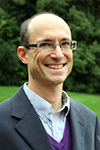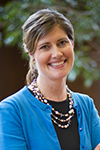Addressing Sexuality in the Classroom: Overcoming Silence and Taboo
Darryl Stephens and Kate Ott will be among the hosts of a pre-Annual Meeting pedagogy workshop, "Teaching Sexuality and Religion to a Changing Student Body" on Friday, November 20, 2015, at the Marriott Marquis in Atlanta. The workshop is funded by the Wabash Center and cosponsored by Drew University Theological School. Learn more and register for the workshop online.
Sexuality. Few topics are as personal, embodied, experiential, culturally dependent, political, and moralized. Attitudes about sexuality are often bound up in issues of shame, guilt, power, and freedom. Sexuality has been at the heart of the US culture wars for nearly half a century; divisions over sexuality are reshaping the religious landscape; public debate about sexuality has reached a fever pitch in US legal discourse; cross-cultural comparisons reveal a wide array of morals and practices; and rates of childhood and adult sexual abuse are staggering. Yet, sexuality conspicuously silences open dialogue given its taboo status in many religious and theological contexts. How do we overcome silence and taboo in order to teach effectively, responsibly, and explicitly about sexuality and religion?
Cultural and Religious Contexts
Complicating discussion of sexuality within a religion or theological classroom are silences and taboos about the topic that contrast sharply with public debate about religion and sexuality in US media and politics. This is a particularly rich historical moment in the life of the American religious landscape and the varied sociocultural responses to sexuality. Mainline Protestant institutions have been—and some are still—in a decade-or-more-long process of discernment over issues of sexual orientation. More recently, Evangelicals have begun to publicly discuss their differences in attitudes and beliefs on this topic. The Roman Catholic Church engages daily in concerns related to reproductive health care issues in addition to ongoing initiatives to address its historic sexual abuse scandal. Islamic communities face stereotyping with regard to gendered practices of worship and dress. Various movements in Judaism are experiencing major shifts in response to divorce, rabbinical ordination of gay and lesbian clergy, and theological questions of gender identity and transition.
Sexuality-related issues are not only concerns within religious communities but also within the lives of students and faculty on campuses across the United States. From California’s “Yes Means Yes” initiative to define affirmative consent to sexual activity to the dozens of colleges and universities under review for insufficient policies and responses to campus sexual assault, the US public consciousness has become inundated with the complexities of our sexual lives, especially in educational contexts. The student populations of religious studies classrooms are also changing significantly. Students have more religiously diverse experiences and report higher rates of “nonaffiliation” with any religious tradition. They are also politically and morally more accepting of historically divisive issues related to sexual orientation and gender identity. Nevertheless, many women and GLBTQ-identified students face high rates of sexual assault and harassment on campus. For students and teachers alike, personal experiences, institutional contexts, and social climate impact teaching and learning related to sexuality and religion.
The contentious nature of sexuality-related religious and theological debate often stems from discomfort discussing sexuality in general, confusing and ever-changing language, embedded racialized, heterosexist, and patriarchal notions of gender dynamics, and a pervasive misperception that sexuality may be discussed apart from the embodiedness of those participating in the dialogue or debate. This is a personal and political topic fraught with tension, and it influences classroom learning even in its absence from the explicit curriculum. Classroom silence about sexuality or even well-intentioned attempts to address issues of sexuality absent attention to the embodied nature of student and teacher alike only reinforce the disconnect between sexuality and the intellectual formation we desire to promote through teaching.
Desired Student Learning Outcomes
Students need to be equipped to consider issues of sexuality and embodiment in the context of their overall educational formation, and overcoming religious silence and taboo in the classroom will help students preparing for any profession to assess how past and current personal factors (gender, social class, religious history, spirituality, relationship status, etc.) as well as institutional factors (policies, climate, etc.) impact their professional competency in handling sexuality issues.
Equipping the next generation of leaders with the skills to maturely discuss sexuality may greatly improve the public discourse about sexuality. A student who can assess how past relationship configurations and religiously informed social constructions impact gender valuations in the workplace may be more sensitive and aware of sexual harassment and gender equity issues. A student who has evaluated the impact of religious histories on sexual mores and policies related to orientation and gender identity may be better suited to foster diversity and nondiscrimination initiatives in religious and secular contexts. More immediately, addressing how religious constructions of gender can contribute to the excuse of date-rape and sexual violence on campus may equip undergraduate students to be upstanders (a proactive stance as a bystander), breaking the silence related to aspects of campus culture that perpetuate violence.
Instructors and religious leaders who are more comfortable with and aware of discussing their own issues of sexuality may contribute to the general health of these students, benefiting them personally as well as contributing to their future vocational contexts. Some of the most important pastoral needs in congregations have to do with experiences of sexuality and its abuse. When ministerial training in homiletics, for example, includes a discussion of sexual violence, gender, and the embodied presence and sexual person of the preacher in the pulpit, sermons change. Once a pastor expresses from the pulpit an understanding of the problem of sexual violence in marriage and a concern for victims, he or she is more likely to be approached for pastoral care by survivors of domestic abuse within the congregation. If a pastor never broaches the subject, survivors in the congregation may never reach out to the pastoral leadership for help.
When student learning inside the classroom begins to address the embodied, experiential realities of sexuality that students encounter everyday outside the classroom, students will be able to integrate their formal education about sexuality with the world around them. This, we believe, will enable a “perspective transformation” in how social, psychological, and cultural factors shape sexuality and our perceptions of it. Yet, few scholars, including those who are sexuality experts within their respective disciplines, have made the shift to teaching sexuality from a content-based “subject matter” to an embodied learning experience that, when holistically approached, considers the embodiment of the instructor and students, institutional location, and social impact of sexuality, religious and theological studies. Such an approach requires great skill and clarity regarding sexuality education more generally.
Transformational Pedagogy
Sexuality is a topic involving contextual, affective, and trans/formational aspects of classroom pedagogy. Contextual features include religious traditions, institutional commitments, online and hybrid mediums of instruction, physical environments, virtual spaces, campus life, and social and political environments. Affective aspects—what professors and students bring to the classroom—include social constructions of sex and gender, personal experiences and attitudes, and various stages of sexual and moral development. Trans/formational aspects include the performative dimensions of teaching sexuality and religion, including classroom strategies, teaching tactics, power dynamics, ethics of self-disclosure, safety and confidentiality, and normative or prescriptive curricular objectives. The complexity of dynamics among these factors creates significant pedagogical challenges, especially when teaching at the intersection of sexuality and religion.
Overcoming the silences and taboos constricting open discourse about sexuality and embodiment requires intentional and careful pedagogy that takes into account multiple contexts, affective aspects, and trans/formational aspects of classroom learning. For example,
- What knowledge and misconceptions about sexuality do students bring to the classroom?
- How does a student’s religious background, experiences, and current context contribute to learning about sexuality?
- How aware are students of the complexity of issues around sexuality and embodiment that they will inevitably or already do face in campus life and career contexts?
- What classroom pedagogies will enable students to become community leaders capable of handling issues of sexuality with responsibility and respect?
Heightened awareness, tried and tested pedagogical strategies, and collegial support are needed to help instructors navigate institutional constraints, respond to student needs, model reflective awareness of the sexuality and embodiment, and create space for the learner’s personal and contextual discernment.
Conclusion
Sexuality and embodiment, topics present regardless of academic discipline or content, can be responsibly addressed in religious and theological studies classrooms. Furthermore, teachers must responsibly discuss religious life and current shifts in religious practices in conjunction with addressing sexuality related concerns. Failing to consider the attitudes, values, and histories that learners bring to the classroom may reinforce religiously based silences and taboos, constricting how sexuality can be taught, learned, and discussed in a democratic polity. When students are better equipped to consider issues of sexuality and embodiment in the context of their overall educational formation, this will contribute to their formation and maturation as adults, community leaders, and/or professionals in ministry.

 Darryl W. Stephens is the director of United Methodist studies at Lancaster Theological Seminary. Kate M. Ott is an assistant professor of Christian social ethics at Drew University Theological School. They are consultant and principal investigator, respectively, for “Teaching Sexuality and Religion to a Changing Student Body: Challenges and Strategies for Classroom Instructors,” funded by a grant from the Wabash Center. This year-long pedagogy project will culminate in a pre-meeting workshop in Atlanta on November 20, 2015, open to all members of the AAR and SBL.
Darryl W. Stephens is the director of United Methodist studies at Lancaster Theological Seminary. Kate M. Ott is an assistant professor of Christian social ethics at Drew University Theological School. They are consultant and principal investigator, respectively, for “Teaching Sexuality and Religion to a Changing Student Body: Challenges and Strategies for Classroom Instructors,” funded by a grant from the Wabash Center. This year-long pedagogy project will culminate in a pre-meeting workshop in Atlanta on November 20, 2015, open to all members of the AAR and SBL.







